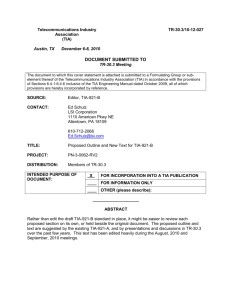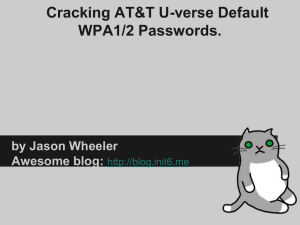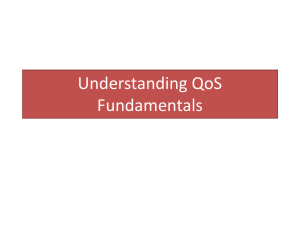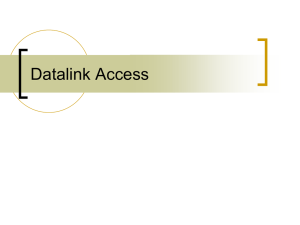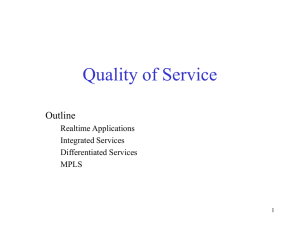31012027-New-Proposed-Text-TIA-921
advertisement
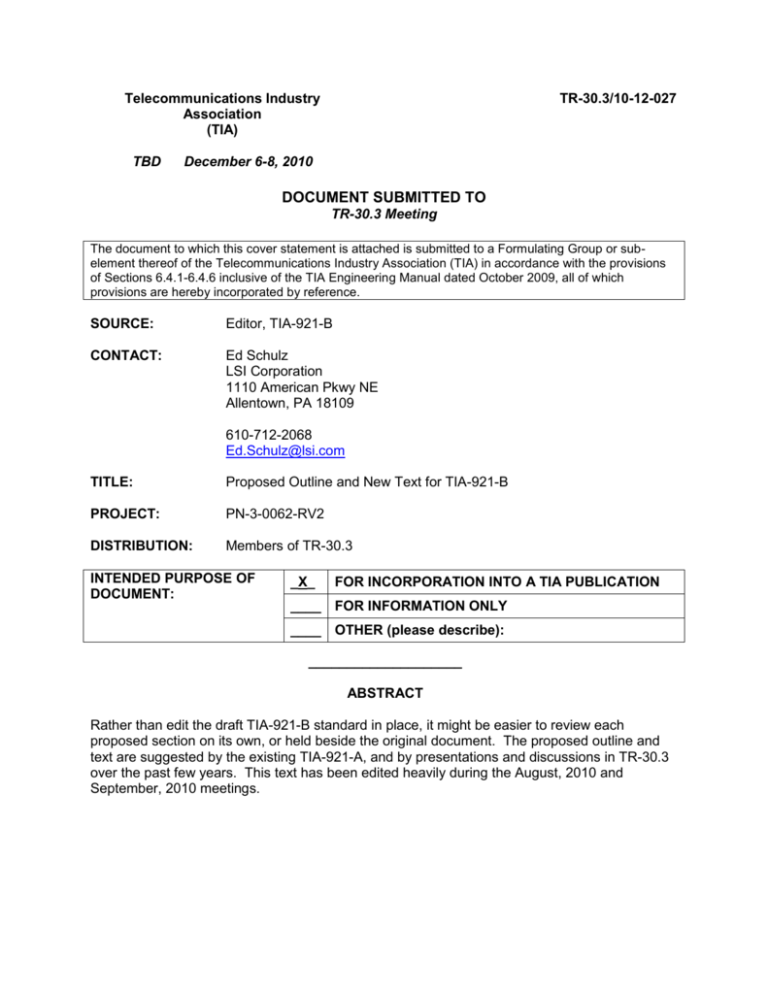
Telecommunications Industry Association (TIA) TBD TR-30.3/10-12-027 December 6-8, 2010 DOCUMENT SUBMITTED TO TR-30.3 Meeting The document to which this cover statement is attached is submitted to a Formulating Group or subelement thereof of the Telecommunications Industry Association (TIA) in accordance with the provisions of Sections 6.4.1-6.4.6 inclusive of the TIA Engineering Manual dated October 2009, all of which provisions are hereby incorporated by reference. SOURCE: Editor, TIA-921-B CONTACT: Ed Schulz LSI Corporation 1110 American Pkwy NE Allentown, PA 18109 610-712-2068 Ed.Schulz@lsi.com TITLE: Proposed Outline and New Text for TIA-921-B PROJECT: PN-3-0062-RV2 DISTRIBUTION: Members of TR-30.3 INTENDED PURPOSE OF DOCUMENT: _X_ FOR INCORPORATION INTO A TIA PUBLICATION ____ FOR INFORMATION ONLY ____ OTHER (please describe): ____________________ ABSTRACT Rather than edit the draft TIA-921-B standard in place, it might be easier to review each proposed section on its own, or held beside the original document. The proposed outline and text are suggested by the existing TIA-921-A, and by presentations and discussions in TR-30.3 over the past few years. This text has been edited heavily during the August, 2010 and September, 2010 meetings. TR-30.3/10-12-023 Foreword (This foreword is not part of this Standard.) ANSI-accredited committee TR-30.3 has developed this TIA-921-B Standard, which defines an IP network model. This model, along with the specified scenarios, are intended for evaluating and comparing communications equipment connected over a converged network. Building upon the experience of creating network nodels, TR-30.3 Subcommittee has created this Network Model for IP Impairments using the similar methodology developed in its previous standards and bulletins: EIA/TIA-496-A-1989: Interface Between Data Circuit Terminating Equipment (DCE) and the Public Switched Telephone Network, which includes a Network Model for Evaluating Modem Performance TIA TSB-37-A-1994: Telephone Network Transmission Model for Evaluating Analog Modem Performance, which became ITU-T Recommendation V.56bis-1995 TIA TSB-38-1994 (and TSB-38-A -2007): Test Procedures for Evaluation of 2-Wire 4 Kilohertz Voice Band Duplex Modems, which became ITU-T Recommendation V.56ter1996 ANSI/TIA/EIA-3700-1999: Telephone Network Transmission Model for Evaluating Analog Modem Performance ANSI/TIA/EIA-793-2001: North American Telephone Network Transmission Model for Evaluating Analog Client and Digitally Connected Server Modems ANSI/TIA-876-2002: North American Network Access Transmission Model for Evaluating xDSL Modem Performance TIA-921-B was approved on [insert date]. It cancels and replaces TIA-921-A (2008) in its entirety. Technical changes from TIA-921-A include: TIA-921-B models the mechanisms that contribute to packet delay, jitter, and loss: interfering streams, queueing delays in network elements, and the characteristics of specific access technologies. The intent is to provide more realism than the earlier version. TIA-921-A defined a mathematical model that fit certain observed network behavior, but was not easily extended to other scenarios. The “likelihood of occurrence” concept is no longer applied to IP networks. TIA-921-B is a true bidrectional model. Impairment levels are updated to keep current with evolving IP networks. The number of standard test cases is greatly reduced. Users can customize test cases to fit their specific needs. There are [insert number] of Annexes in this Standard. Annex A [and Annex B] are normative and are considered part of this Standard. Annex [C and Annex D] are informative and are not considered part of this Standard. [Annexes X, Y, Z are provided electronically, rather than in print.] Introduction TIA-921-B describes a model of Internet Protocol (IP) networks for the purpose of evaluating the performance of IP streams. The focus is on packet delay, delay variation, and loss. IP streams from any type of network device can be evaluated using this model. Page 2 of 19 TR-30.3/10-12-023 Emphasis is given to the fact that manufacturers of communications equipment and service providers are interested in a specification that accurately models the IP network characteristics that determine performance. Evaluators desire a definitive set of simple tests that properly measure the performance of communications devices from various manufacturers. Therefore, the objective of this standard is to define an application-independent model (e.g. data, voice, voiceband data, and video) that is representative of IP networks, that can be simulated at reasonable complexity, and that facilitates practical evaluation times. The IP network model presented herein represents a snapshot of actual network data provided by anonymous IP service providers and IP network equipment manufacturers in the 2010 timeframe, and will continue to evolve as more statistical information becomes available and as the IP network evolves. Scope This Standard is broadly applicable to the evaluation of any equipment that terminates or routes traffic using Internet Protocol. This Standard can also be used to evaluate media streams or other protocols carried over IP networks. Examples of the types of equipment that can be evaluated using this model include: IP-connected endpoints: o IP network devices (such as: user agents, call agents, media servers, media gateways, application servers, routers, switches, etc.) o IP video (IPTV, video conferencing, telepresence, etc.) o IP phones (including soft phones) o IAF (Internet Aware Fax) PSTN-connected devices through IP gateways: o POTS through Voice-over-IP (VoIP) gateways o T.38 facsimile devices and gateways o V.150.1 and V.152 (voiceband data, VBD) modem-over-IP gateways o TIA-1001 and V.151 textphone-over-IP gateways The IP network model can be used in two ways: Test an IP stream under simulated network conditions Test an IP stream in real time using hardware emulation of the network model. The IP network model can be used to study and to understand: the interaction of different traffic mixes the effects of QoS and queuing on different types of traffic packet delay variation and packet loss. Whether in software simulation or real-time hardware emulation, users can select from several test cases specified in this Standard. Users can optionally define their own test cases. This model has the following limitations: Some VoIP networks may utilize PSTN at one or both ends of the connection through a media gateway. This model only addresses the IP portion of the network and does not address the PSTN portion of the end-to-end connection. The network model represented in this Standard does not model all possible connections that can be encountered between devices. Page 3 of 19 TR-30.3/10-12-023 This Standard only specifically includes GPON and DSL access technologies. Characteristics of other access technologies such as CATV and wireless are for further study. Abnormal events such as link failures and route flaps (and the packet reordering that such events can cause) are not included in this Standard. The standard test cases use streams of interfering traffic that were captured on live networks. While realistic, they are still just examples; users could substitute their own files of interfering traffic. The LAN-to-LAN test cases of TIA-921-A are now modeled as two cascaded TIA-921-B core-to-LAN segments. [See Annex] The IP network model presented herein is based on an informal survey of anonymous IP service providers and IP network equipment manufacturers in the 2010 timeframe and will continue to evolve as more statistical information becomes available and as the IP network evolves. Informative References At the time of publication, the editions indicated were valid. All standards and bulletins are subject to revision, and parties to agreements based on this Standard are encouraged to investigate the possibility of applying the most recent editions of the standards published by them. ETSI TIPHON TR 101 329 - Part 2, Quality of Service (QoS) Classes IEEE 802.11A-1999, Information Technology Telecommunications and Information Exchange Between Systems – LAN/MAN IEEE 802.11B/COR 1-2001, Wireless LAN MAC and PHY Specifications Amendment 2: Higher Speed Physical Layer Extension In The 2.4GHz Band IEEE 802.11G-2003, Wireless LAN MAC and PHY Specifications Amendment 4: Further High Data Rate Extension In The 2.4GHz Band ITU-T Recommendation G.1050 (2007), Network Model for Evaluating Multimedia Transmission Performance Over Internet Protocol ITU-T Recommendation G.107 (2009), The E-model, a computational model for use in transmission planning ITU-T Recommendation G.108 (1999), Application of the E-model: A planning guide ITU-T Recommendation G.114 (2003), One way transmission time ITU-T Recommandation T.38 (2007), Procedures for real-time Group 3 facsimile communication over IP networks ITU-T Recommendation V.150.0 (2003), Modem-over-IP Networks: Foundation ITU-T Recommendation V.150.1 (2003), Procedures for the end-to-end connection of V-series DCEs over an IP Network Page 4 of 19 TR-30.3/10-12-023 ITU-T Recommendation V.152 (2005), Procedures for supporting Voice-Band Data over IP Networks ITU-T Recommendation Y.1541 (2006), Network performance objectives for IP-Based services ANSI/TIA-810-B-2006, Telecommunications – Telephone Terminal Equipment – Transmission Requirements for Narrowband Voice over IP and Voice over PCM Digital Wireline Telephones TIA-1001 (2004), Transport of TIA-825-A Signals over IP Networks TIA TSB116-A-2006, Telecommunications – IP Telephony Equipment – Voice Quality Recommendations for IP Telephony ANSI/TIA-912-A-2004, Telecommunications – IP Telephony Equipment – Voice Gateway Transmission Requirements Definitions and Abbreviations Definitions For the purposes of this standard, the following definitions shall apply. burst loss – a high density of packet loss over time, or loss of sequential packets, due to congestion, bandwidth limitation, line errors, or rerouting (delay translated into loss due to implementation) on the network. delay – the time required for a packet to traverse the network or a segment of the network. See latency. downstream – a transmission from a service provider toward an end user. end-to-end network – pertaining to an entire path from one endpoint to another. Metrics may refer to a single segment (example: core delay) or to the entire path (example: end-to-end network delay). gateway – a network device that acts as an entrance to another network. One function is to convert media provided in one type of network to the format required in another type of network. For example, a gateway could terminate bearer channels from a switched circuit network (e.g., DS0s) and media streams from a packet network (e.g., RTP streams in an IP network). interferer – a packet stream that contends with the test stream of interest for a limited network resource, such as a link buffer. IP Network – a network based on the Internet Protocol, a connectionless protocol. jitter – variation in packet delay. latency – an expression of how much time it takes for a packet of data to get from one designated point to another. See delay. MTU Size – the largest size packet or frame, specified in octets, that can be sent in a packet- or frame-based network such as the Internet. packet loss – the failure of a packet to traverse the network to its destination. (This model does not take into account discards due to buffer overflow.) peak jitter – the maximum variation of delay from the mean delay. peak-to-peak jitter – the full range of packet delay from the maximum amount to the minimum amount. QoS Edge Routing – routing between the customer premises network and the service provider network based on Quality of Service classification values. reordered packets– A packet that arrives at the destination with a packet sequence number that is smaller than the previous packet is deemed a reordered packet. Page 5 of 19 TR-30.3/10-12-023 route flap – repeated changes in a path due to updates to a routing table. The network model simulates the effect of route flaps by making incremental changes in the delay values of the core segment. sequential packet loss – two or more consecutive lost packets. upstream – a transmission from an end user toward a service provider. Abbreviations For the purposes of this standard, the following abbreviations shall apply. BER: Bit Error Rate CATV: Cable Television DSL: Digital Subscriber Line DSLAM: DSL Access Multiplexer IP: Internet Protocol IPTV: Internet Protocol Television LAN: Local Area Network MTU: Maximum Transmission Unit OLT: Optical Line Termination ONT: Optical Network Termination OTT: Over-the-top (streaming video, non-IPTV) PBS: Peak Burst Size (pcap generator) pcap: Packet Capture (file format) PIR: Peak Information Rate (pcap generator) POTS: Plain Old Telephone Service PSTN: Public Switched Telephone Network QoS: Quality of Service SLA: Service Level Agreement VoIP: Voice over Internet Protocol VTC: Video Teleconferencing Description of the Model Overview The new IP network model of this Standard is embodied in a discrete event software simulator. In a real sense, the simulator is the model. Other implementations are possible, including realtime hardware network emulators for test lab use, but their behavior must match that of the simulator presented here. The IP network is modeled as a network of basic elements. Figure 1 shows the basic network element, called a “switch.” Page 6 of 19 TR-30.3/10-12-023 Third Interferer Second Interferer Interfering Stream Generator Test Stream Input to This Stage Store and Forward Test Stream Output from This Stage Link Latency + Packet Priority Queues with Loss Disturbance Packets Figure 1: Model Basic Network Switch Element The basic network elements are wired in series into a specific network topology as described in 0 This is an outline of the simulator processing: 1. A packet generator drives packets into the simulator. The arrival times and sizes of the test stream packets and the interfering stream packets are read from pcap files. 2. A switch receives packets on its ingress ports, and determines where packets should go next. 3. A switch schedules each packet for transmission out one of its egress ports. 4. Wires connect the egress port of one switch to the ingress port of another switch. 5. The process repeats for all packets through all switches and wires. 6. Packet arrival and departure times are stored in a file for analysis. The sections that follow explain the components of the model in more detail: Network Topology Interfering Stream Files Models of Network Elements Simulation Inputs Simulation Outputs Packet Scheduling Algorithm Network Topology Error! Reference source not found. (LAN to LAN) illustrates an end-to-end network with LAN and access links on each side of the core as would occur in a client-to-client application such as VoIP. Error! Reference source not found. (Core to LAN) illustrates an end-to-end network with LAN and access on the destination side, but not on the source side as would occur in a server-to-client application such as IPTV or web server access over the internet. [insert diagram: high-level LAN-LAN (5 boxes), Core-LAN (3 boxes)] [insert diagram showing detail, like slide 12] Page 7 of 19 TR-30.3/10-12-023 Models of Network Elements The various types of network elements considered in this model [as depicted in Figure previous] are listed as columns in Table 1: core switches edge router access head end device o DSLAM o GPON OLT access subscriber end device o DSL modem o GPON ONT firewall (as part of residential gateway, for example)LAN wires between devices Table 1 lists the attributes of each element in the network model: # switches: For the core section only, there are between 3 and 10 cascaded Gigabit Ethernet switches Link down rate: refers to the direction from the core toward the premises Link up rate: refers to the direction from the premises toward the core Delay: the one-way flat delay of the element QoS: Indicates that the element implements QoS priority scheduling Buffer size: For devices with QoS the queue at each priority level holds 96 kBytes. BER: The bit error rate of the physical access link “Down” indicates the direction; “up” is toward the core. # switches LAN Firewall Wire GPON ONT GPON Access OLT DSL Modem DSL Access DSLAM 3 to 10 Link rate down (Mbit/s) Link rate up (Mbit/s) Delay 1000 1000 3 to 33 5 to 50 100 100 1000 1000 100 100 ns 2 to 35 1 ms 100 10 to 300 ms 1 to 3 1 ms QoS Buffer size (kBytes) BER Wire Edge Router Wire Attribute Core switch Table 1: Network Model Element Attributes 96 96 1 to 7 96 96 10-8 Page 8 of 19 1 to 7 96 96 10-12 96 TR-30.3/10-12-023 to 10-7 to 10-9 Interfering Stream Files [Les] [where they came from] [remember to include telepresence files from Phil H] [how selected] [bidirectional] [how processed: strip payload (or not), optionally scaled, optionally smoothed] [how described by time series, PDV histogram] [QoS assigned as managed or residual bandwidth (or does that belong elsewhere in the Standard?)] [impairment severity is a function of pcap statistics, number and rate of streams] [files provided on disk] Simulation Inputs Input to the simulator is in the form of PCAP files. These files are driven into the simulation as specified by the timestamps in PCAP files. The payload of the PCAP files, if present, is carried along with the packets in the simulation and placed in the output files. The simulation parameter settings can adjust the timing of the packets driven into the simulation, for example to speed up or slow down the playback, or to smooth out unintended burstiness. A full list of the adjustable parameters for the PCAP packet generator is given in [Annex]. [network topology input] [where pcap files are inserted: artificially all at the start] Table 2: Network Model Simulation Input Parameters Network Element Core Impairment / Interferer Parameter Range Number of Switches Buffer Size (kB) Rate (Gbit/s) Total Core Link Delay (ms) 3 to 10 96 1 10 to 300 Buffer Size (kB) 96 Edge Router Access (pick one technology) GPON Access Rate Down (Mbit/s) Access Rate Up (Mbit/s) Residual BER Buffer Size (kB) Delay (ms) Page 9 of 19 5 to 50 2 to 35 10-12 to 10-9 96 1 TR-30.3/10-12-023 DSL Access Rate Down (Mbit/s) Access Rate Up (Mbit/s) Residual BER Buffer Size (kB) Delay (ms) 3 to 33 Buffer Size (kB) 96 Buffer size 96 Effective Rate (Mbits/s) 100 1 to 3 10-8 to 10-7 96 1 "Modem" / ONT Firewall LAN Managed Bandwidth IPTV HD Stream 1 - CBR (qty) Downstream Rate (Mbit/s) Upstream Rate (Mbit/s) Shaping QoS IPTV HD Stream 2 - VBR (qty) Downstream Rate (Mbit/s) Upstream Rate (Mbit/s) Shaping QoS IPTV SD Stream 1 - CBR (qty) Downstream Rate (Mbit/s) Upstream Rate (Mbit/s) Shaping QoS IPTV SD Stream 2 - VBR (qty) Downstream Rate (Mbit/s) Upstream Rate (Mbit/s) Shaping QoS VoIP/Fax (qty) Downstream Rate (Mbit/s) Upstream Rate (Mbit/s) QoS Residual Bandwidth Page 10 of 19 8 0.01 PIR/PBS 8 0.01 PIR/PBS 2 0.01 PIR/PBS 2 0.01 PIR/PBS 0.064 0.064 TR-30.3/10-12-023 Peer-to-peer Rate Down Peer-to-peer Rate Up QoS POP3 Rate Down POP3 Rate Up QoS HTTP Rate Down HTTP Rate Up QoS Youtube Rate Down Youtube Rate Up QoS OTT2 Rate Down OTT2 Rate Up QoS VoIP/Fax Rate Down VoIP/Fax Rate Down QoS 1.89 0.768 0.5 0.02 1.7 0.007 7 0.128 1 0.025 0.064 0.064 Simulation Outputs The simulator output is a file for each direction – upstream and downstream – that lists the precise arrival time and delay of each packet in the stream under test from model ingress to egress. Packets that are dropped because of network congestion are noted. [What does Delay mean when the packet is dropped?] See the example in Table 3. Page 11 of 19 TR-30.3/10-12-023 Table 3: Example Simulator Output [replace with recent output] Source: Creation Date: Description: ContentEncoding : Delay Unit: Time 2 2.064531 2.068719 2.083353 2.103442 2.129744 2.136147 2.160704 2.276267 2.306837 2.331988 2.36096 2.443818 TIA-921-B 5/5/2010 Misc Downstream 2 ASCII ms Delay 62.540836 62.5377494 62.106312 62.21563497 62.40617898 62.154648 62.401416 63.0072554 62.69638617 63.43353741 62.41461574 62.09868 63.41120351 Drop 0 0 0 0 0 1 0 1 1 1 1 1 0 The simulator may generate a pcap file containing the same information, suitable for processing by any program that recognizes the pcap file format. [Should examples of PDV and time series be included here, or in an informative Annex?] [Show time series and PDV from the same simulation] Packet Scheduling Algorithm Capitalized nouns in the following description refer to objects in the C++ simulator source code. A Packet is driven into the simulation from a PacketGenerator, usually by reading Packets from a PCAP file, and sending them into a Port on a Switch. The Switch receives the Packet, determines where it should go next, and Schedules it for transmission out one of its egress Ports. The egress Port is connected by a Wire to another Switch and the Wire schedules the packet for ingress on the next Switch after the wire’s delay. This process repeats for the entire network topology being simulated and for all packets being simulated. When packets reach their final destination, they are stored in a file for post-analysis. Normative Annex [X], included as an electronic attachment, contains the C++ source code of the simulator. Annex [Y] is a detailed description of the simulator code. IP Network Impairment Level Requirements An implementation of the network model shall create impairments that conform to the impairment levels specified in this section. Page 12 of 19 TR-30.3/10-12-023 Service Test Profiles Error! Reference source not found. represents service test profiles and the applications, node mechanisms and network techniques associated with them. ITU-T Y.1541 uses a similar approach, but a one-to-one mapping to these service profiles may not be possible. Service Test Profiles Well-Managed IP Network (Profile A) PartiallyManaged IP Network (Profile B) Unmanaged IP Network, Internet (Profile C) Applications (Examples) High quality video and VoIP, VTC (Real-time applications, loss sensitive, jitter sensitive, high interaction) VoIP, VTC (Real-time applications, jitter sensitive, interactive) Lower quality video and VoIP, signaling, transaction data (highly interactive) Transaction data, interactive Short transactions, bulk data (low loss) Traditional Internet applications (default IP networks) Node Mechanisms Strict QoS, guaranteed no over subscription on links Separate queue with preferential servicing, traffic grooming Separate queue, drop priority Long queue, drop priority Separate queue (lowest priority) Network Techniques Constrained routing and distance Less constrained routing and distances Constrained routing and distance Less constrained routing and distances Any route/path Any route/path The following three test profiles are used in this IP network model that can be associated with Service Level Agreements (SLA): Well-Managed Network (Profile A) – a network with no over-committed links that employs QoS edge routing. Partially-Managed Network (Profile B) – a network that minimizes over-committed links and has one or more links without QoS edge routing. Unmanaged Network (Profile C) – an unmanaged network such as the Internet that includes over-committed links and has one or more links without QoS edge routing. These tables represent end-to-end impairment levels, including LAN and access. In Tables 2, 3 and 4, the total packet loss is the sum of the sequential packet loss and random packet loss. Note that service provider SLAs only guarantee characteristics of the core section of the network. Page 13 of 19 TR-30.3/10-12-023 Impairment Type Units Profile A Well-Managed Range (min to max) Profile B Partially-Managed Range (min to max) Profile C Unmanaged Range (min to max) One Way Latency ms 20 to 100 (regional) 90 to 300 (intercontinental) 20 to 100 (regional) 90 to 400 (intercontinental) 20 to 500 Jitter (peak to peak) ms 0 to 50 0 to 150 0 to 500 Sequential Packet Loss ms Random loss only (except when link failure occurs) 40 to 200 40 to 10,000 Rate of Sequential Loss sec-1 Random loss only (except when link failure occurs) < 10-3 < 10-1 Random Packet Loss % 0 to 0.05 0 to 2 0 to 20 Reordered Packets % 0 to 0.001 0 to 0.01 0 to 0.1 Impairment Combination Standard Test Cases [say how these were chosen so that the simulation results align with the impairment level requirements just described.] realistic mix of typical traffic, with QoS priority levels span easy to difficult test cases results align with the impairment level requirements just described access rates and technologies for GPON and DSL in 2011 [Explain naming of the test cases. (Les)] [Where do we describe how these test cases can be used? User guide annex?] [somehow fit the spreadsheet here] Annex (Normative): Description of Discrete Event Simulator Simulation Parameter files The parameters for running the simulation are given in a TCL file. The advantage of using TCL as a parameter file format is that it is a well-known file format, and it is extensible so that users can further customize the behavior of the simulation to suit their particular needs. An example of how this helps is that it gives a convenient way to comment out portions of code and to print messages to the screen for information or debugging. [Welch] [Ousterhout] Page 14 of 19 TR-30.3/10-12-023 At the very top of a parameter file, the user must include the common support routines from the file tc/common.tcl. source "tc/common.tcl" The first section of the parameter file consists of variable settings using the TCL “set” command. It is no different from setting a normal variable in TCL, except that the names of the variables are specific to the simulator. The example below sets the simulation length to 10 minutes (600 seconds) set SimLengthSeconds [expr 10*60] Note here that a TCL expression is used to make it easy to specify 10 minutes without needing to do the multiplication manually. Next, set the CORE network parameters set NumCoreSW set CORE_Latency set CORE_Speed 5 20E-3 1E9 Next, set the Remote LAN speed set RLAN_Speed 100E6 Next, set the Remote Access parameters set set set set RACC_SpeedDown RACC_SpeedUp RACC_BER_Fwd RACC_BER_Rev 33E6 2E6 1E-12 1E-12 Next set the Buffer sizes in the network elements set set set set CORESW_BufSizeBytes DSLAM_BufSizeBytes Firewall_BufSizeBytes Modem_BufSizeBytes [expr 1*65536] [expr 1*65536] 65536 65536 The next section of the parameter file specifies the PacketGenerators that read input PCAP files and drive them into the simulation. Page 15 of 19 # ============================================================================================================= # Upstream PCAP Generators # - - - - - - - - - - - - - - - - - - - - - - - - - - - - - - - - - - - - - - - - - - - - - - - - - - - - - - # Name File Start BW PPM Rand Prio Repeat PIR PBS # - - - - - - - - - - - - - - - - - - - - - - - - - - - - - - - - - - - - - - - - - - - - - - - - - - - - - - PCAP_Generator 2.0 -1 1.0 0.0 0.0 PCAPRevI3 1 vocal_g729_dir2 # ------------------------------------------------------------------------------------------------------------- # ============================================================================================================= # Downstream PCAP Generators # - - - - - - - - - - - - - - - - - - - - - - - - - - - - - - - - - - - - - - - - - - - - - - - - - - - - - - # Name File Start BW PPM Rand Prio Repeat PIR PBS # - - - - - - - - - - - - - - - - - - - - - - - - - - - - - - - - - - - - - - - - - - - - - - - - - - - - - - PCAP_Generator -1 PCAPFwdI7 vocal_g729_dir1 2.0 1.0 0.0 0.0 1 # - - - - - - - - - - - - - - - - - - - - - - - - - - - - - - - - - - - - - - - - - - - - - - - - - - - - - - PCAP_Generator -1 PCAPFwdI3 0.0 0.514 sh_12Mb_cbr_deburst 0.0 0.5 2 PCAP_Generator -1 PCAPFwdI5 sh_6Mb_cbr_deburst 10.0 0.260 0.0 0.5 2 # - - - - - - - - - - - - - - - - - - - - - - - - - - - - - - - - - - - - - - - - - - - - - - - - - - - - - - PCAP_Generator -1 PCAPFwdI9 YouTube1080p_Down_nopayload 2.0 0.16 0.0 0.9 7 PCAP_Generator -1 PCAPFwdI10 Hulu480p_Down_nopayload 2.0 0.25 0.0 0.9 7 # ------------------------------------------------------------------------------------------------------------- TR-30.3/10-12-023 The parameters for the input PCAP generators are specified in columns as shown above. The meanings of the columns is described briefly below Page 16 of 19 TR-30.3/10-12-023 Instance Name – the instance name of the generator. This depends on the specific top level simulation file. Filename – the file name of the input PCAP file. Assumes that the PCAP file is in the ./pcap subdirectory and has a .pcap suffix so neither of these needs to be specified in the parameter file. Start Delay – the relative delay, in seconds, before starting generator. Bandwidth Scale Factor – a scale factor that divides the relative timestamps in the PCAP file. A value of 1.0 makes no change to the timing of the packets. A value of 2.0 causes the packets to be transmitted twice as fast by dividing the timestamps in the PCAP file by 2.0. PPM offset – this is similar to the Bandwidth Scale Factor, but is expressed in units of parts per million. A value of 0 ppm makes no change to the rate at which packets are generated. A value of 100ppm reduces the timestamps in the PCAP file by 100 ppm, which causes the file to be transmitted 100 ppm faster than nominal. Randomness – this is a value from 0.0 to 1.0 that adds a percentage of randomness to the interpacket times. A value of 0.5 represents 50% randomness for inter-packet timing. For example, if the time between two consecutive packets in the PCAP file is 1 millisecond, and the randomness is 0.5, then the actual time between those two consecutive packets could be in the range 500 microsecond to 1.5 millisecond. Priority – this is the assigned priority of the packets Repeat Count – this is the number of times to repeat the PCAP file. A value of 0 or 1 means to play the file once, a value of two or more will play the file that many times, and a value of -1 will repeat the file forever. Shaper PIR and Shaper PBS – these parameters control a shaper that is built into the PacketGeneratorPCAP object. The PIR is the Peak Information Rate and is expressed in bits per second, so the value 10E6 represents 10 million bits per second. The PBS is the Peak Burst Size and is expressed in bits. Normally the PIR should be set safely above (e.g. 2.5x) the bit rate of a VBR video stream, unless the goal is to smooth out microbursts. Page 17 of 19 TR-30.3/10-12-023 The next section of the parameter file specifies the Packet Monitors that write output PCAP files and “.out” files # ===================================================== # Downstream PCAP Monitors # - - - - - - - - - - - - - - - - - - - - - - - - - - # Name File # - - - - - - - - - - - - - - - - - - - - - - - - - - PCAP_Monitor PktMonPCAPFwdI7 VoIP1_down # PCAP_Monitor PktMonPCAPFwdI3 HD_8Mbit_cbr PCAP_Monitor PktMonPCAPFwdI5 SD_2Mbit_cbr # PCAP_Monitor PktMonPCAPFwdI9 YouTube_down PCAP_Monitor PktMonPCAPFwdI10 Hulu_down # ----------------------------------------------------# ===================================================== # Upstream PCAP Monitors # - - - - - - - - - - - - - - - - - - - - - - - - - - # Name File # - - - - - - - - - - - - - - - - - - - - - - - - - - PCAP_Monitor PktMonPCAPRevI3 VoIP1_up # ----------------------------------------------------- There are only two parameters for the PCAP monitor command Instance Name – the instance name of the monitor. This depends on the specific top level simulation file. File Name – the base name of the output files. The output files will be placed into the same directory as the parameter file and will have suffixes .pcap and .out. Note that if a PCAP_Monitor line is commented out or not present, the output files will not be written. This is helpful in situations where only a subset of the output files are needed so that disk space can be saved. The simulation predefines two global variables for use by the TCL code in the parameter file $paramfile – this is the name of the parameter file $paramdir – this is the directory name of the parameter file Page 18 of 19 TR-30.3/10-12-023 Annex (Normative): C++ Source Code of Discrete Event Simulator [electronic attachment] Annex (Normative): Packet Capture Files of Interfering Traffic [list file names and sufficient description of each] [electronic attachments] Annex (Normative): Simulator Output [list file names. Describe contents of each file.] [electronic attachments] Annex (Informative): Rationale for Network Model pcap stream selection pcap bit rates access technologies, bit rates, and error rates network topology buffer size (equipment vendor) queuing algorithms Annex (Informative): User’s Guide Emulator Implemntation For a specified test case, the simulation produces delay and loss characteristics that can be used in a real-time emulator. The emulator accepts a packet stream under test, and plays out the same stream with packet delays and losses that match the corresponding simulation. An emulator must shape the stream under test to account for the “self-interference” effect. Packets that arrive too close together in time contend for the available bandwidth in the emulated network. The amount of shaping depends on the effective bandwidth available to the stream under test in the given test case. This available capacity is the rate of the access link (the lowest-rate link in the network) less the sum of the rates of the interfering streams at QoS priority the same or higher than the stream under test. [LAN-TO-LAN: Emulator only. Concatenate two core-to-LAN models. Losses add (OR fn). Fixed delays add, but maybe that’s not relevant since...Jitter is a result of adding delays on each half, packet by packet. Interfering streams enter in the core, but it depends on business or residence.] DelayLL = DelaySev1 + DelaySev2 LossLL = LossSev1 “or” LossSev2 BW LL = Min[EBSev1, EBSev2] (EB = Effective BW) Practical Use of Test Cases ____________________ Page 19 of 19

